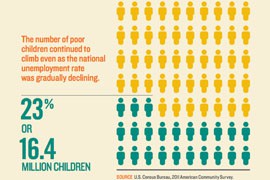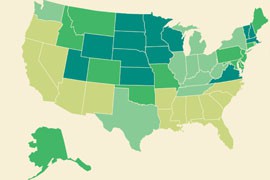TOP: Nationally, 23 percent of children, or 16.4 million youth, lived in
poverty in 2011, up from 22 percent the year before, according to a new
report. In Arizona, the share of children in poverty was 27 percent in
2011, according to the KidsCount report. (Graphic by KidsCount/Annie E.
Casey Foundation)
BOTTOM: Arizona ranked in the bottom fourth of states on economic well-being of its children in 2011, according to a report released this week. Most states saw a decline in the economic welfare of their children from 2010, acccording to the KidsCount report. (Graphic by KidsCount/Annie E. Casey Foundation)
By XI CHEN Cronkite News Service
WASHINGTON – Arizona slipped from 46th to 47th place among states in 2011 for the well-being of its children on a variety of measures, including poverty, education, health, and family and community factors, according to a new report.
KidsCount 2013, released Monday by the Annie E. Casey Foundation, ranked Arizona ahead of only, Nevada, Mississippi and New Mexico for 2011.
“It’s disappointing that we are so far at the bottom,” said Dana Naimark, president of the Children’s Action Alliance in Arizona. But she expressed confidence that the state can “greatly improve” by focusing on specific areas, including preschool participation.
The report said that children’s academic achievement and health improved in most states between 2010 and 2011, but that their economic well-being continued to decline in the wake of the recession.
“There were some improvements, but families are still struggling” nationwide, said Laura Speer, Casey’s associate director for policy reform and data.
She said the most disturbing indicator was “the fact that the child poverty rate continued to go up.” The report called growing up in poverty “one of the greatest threats to healthy child development,” because it can contribute to behavioral, social and emotional problems and poor health.
Nationally, 23 percent of U.S. children in 2011 lived in poverty – defined as income below $22,811 for a family of four – up from 22 percent in 2010.
In Arizona, the number of children in poverty was 27 percent in 2011, moving the state from 37th place to 42nd place overall.
The state’s relatively high rate of poverty and the number of children who are not in preschool were two main factors weighing against the state, Speer said.
Naimark agreed that child poverty is a concern and it could “definitely keep Arizona down in the rankings.”
“Even though our economy is slowly recovering, kids are left behind in some ways,” she said.
And while 54 percent of the nation’s 3- and 4-year-olds did not attend preschool, the rate in Arizona was 67 percent in 2011, second-worst in the nation, the report said.
“That’s a problem because we know children who attend preschool are more prepared,” said Naimark, who called preschool education “an important investment in the children’s long-term success.”
“If we can boost the participation, we can move our ranking up,” she said, but more importantly can “have great positive impact” on families, the workforce and the education system in the state.
She cited a lack of funding as one possible explanation for the problem.
“In Arizona, we’ve cut out our state funding for full-day kindergarten and preschool, which impacted the number of children who can access preschool,” she said.
The result also worries Rhian Allvin, CEO of First Thing First, an organization created by voters in 2006 to serve children under age 5 in Arizona.
She said the organization invested $74 million in fiscal 2013 to improve the quality of and access to early learning. And she noted that the just-passed state budget includes $9 million in child-care subsidies.
“Without those funds, thousands of children from low-income working families might have lost access to child care and preschool,” she said of the child-care funding.
“Even with this significant investment, many young kids don’t have access to early-learning opportunities,” said Allvin.
She noted that children who have access to high-quality early learning score higher on school readiness assessments and are more likely to graduate and go on to college.
Allvin called the KidsCount report a powerful reminder that “we need give more children in Arizona the opportunity to start school prepared to succeed.”
“We have the road map on how to do that, and the best way is to make sure that the kids walk into the kindergarten door and ready to hit the ground running,” she said.
The KidsCount report rated states for their performance in four areas in 2011: economic well-being, education, health, and family and community. Those were combined to give an overall ranking:
1. New Hampshire
2. Vermont
3. Massachusetts
4. Minnesota
5. New Jersey
6. North Dakota
7. Iowa
8. Nebraska
9. Connecticut
10. Maryland
11. Virginia
12. Wisconsin
13. Maine
14. Utah
15. Wyoming
16. Kansas
17. Pennsylvania
18. South Dakota
19. Washington
20. Idaho
21. Colorado
22. Delaware
23. Illinois
24. Ohio
25. Hawaii
26. Rhode Island
27. Missouri
28. Montana
29. New York
30. Indiana
31. Michigan
32. Oregon
33. Alaska
34. Kentucky
35. North Carolina
36. Oklahoma
37. West Virginia
38. Florida
39. Tennessee
40. Arkansas
41. California
42. Texas
43. Georgia
44. Alabama
45. South Carolina
46. Louisiana
47. Arizona
48. Nevada
49. Mississippi
50. New Mexico
BOTTOM: Arizona ranked in the bottom fourth of states on economic well-being of its children in 2011, according to a report released this week. Most states saw a decline in the economic welfare of their children from 2010, acccording to the KidsCount report. (Graphic by KidsCount/Annie E. Casey Foundation)
By XI CHEN Cronkite News Service
WASHINGTON – Arizona slipped from 46th to 47th place among states in 2011 for the well-being of its children on a variety of measures, including poverty, education, health, and family and community factors, according to a new report.
KidsCount 2013, released Monday by the Annie E. Casey Foundation, ranked Arizona ahead of only, Nevada, Mississippi and New Mexico for 2011.
“It’s disappointing that we are so far at the bottom,” said Dana Naimark, president of the Children’s Action Alliance in Arizona. But she expressed confidence that the state can “greatly improve” by focusing on specific areas, including preschool participation.
The report said that children’s academic achievement and health improved in most states between 2010 and 2011, but that their economic well-being continued to decline in the wake of the recession.
“There were some improvements, but families are still struggling” nationwide, said Laura Speer, Casey’s associate director for policy reform and data.
She said the most disturbing indicator was “the fact that the child poverty rate continued to go up.” The report called growing up in poverty “one of the greatest threats to healthy child development,” because it can contribute to behavioral, social and emotional problems and poor health.
Nationally, 23 percent of U.S. children in 2011 lived in poverty – defined as income below $22,811 for a family of four – up from 22 percent in 2010.
In Arizona, the number of children in poverty was 27 percent in 2011, moving the state from 37th place to 42nd place overall.
The state’s relatively high rate of poverty and the number of children who are not in preschool were two main factors weighing against the state, Speer said.
Naimark agreed that child poverty is a concern and it could “definitely keep Arizona down in the rankings.”
“Even though our economy is slowly recovering, kids are left behind in some ways,” she said.
And while 54 percent of the nation’s 3- and 4-year-olds did not attend preschool, the rate in Arizona was 67 percent in 2011, second-worst in the nation, the report said.
“That’s a problem because we know children who attend preschool are more prepared,” said Naimark, who called preschool education “an important investment in the children’s long-term success.”
“If we can boost the participation, we can move our ranking up,” she said, but more importantly can “have great positive impact” on families, the workforce and the education system in the state.
She cited a lack of funding as one possible explanation for the problem.
“In Arizona, we’ve cut out our state funding for full-day kindergarten and preschool, which impacted the number of children who can access preschool,” she said.
The result also worries Rhian Allvin, CEO of First Thing First, an organization created by voters in 2006 to serve children under age 5 in Arizona.
She said the organization invested $74 million in fiscal 2013 to improve the quality of and access to early learning. And she noted that the just-passed state budget includes $9 million in child-care subsidies.
“Without those funds, thousands of children from low-income working families might have lost access to child care and preschool,” she said of the child-care funding.
“Even with this significant investment, many young kids don’t have access to early-learning opportunities,” said Allvin.
She noted that children who have access to high-quality early learning score higher on school readiness assessments and are more likely to graduate and go on to college.
Allvin called the KidsCount report a powerful reminder that “we need give more children in Arizona the opportunity to start school prepared to succeed.”
“We have the road map on how to do that, and the best way is to make sure that the kids walk into the kindergarten door and ready to hit the ground running,” she said.
REPORT CARD ON KIDS
The KidsCount report rated states for their performance in four areas in 2011: economic well-being, education, health, and family and community. Those were combined to give an overall ranking:
1. New Hampshire
2. Vermont
3. Massachusetts
4. Minnesota
5. New Jersey
6. North Dakota
7. Iowa
8. Nebraska
9. Connecticut
10. Maryland
11. Virginia
12. Wisconsin
13. Maine
14. Utah
15. Wyoming
16. Kansas
17. Pennsylvania
18. South Dakota
19. Washington
20. Idaho
21. Colorado
22. Delaware
23. Illinois
24. Ohio
25. Hawaii
26. Rhode Island
27. Missouri
28. Montana
29. New York
30. Indiana
31. Michigan
32. Oregon
33. Alaska
34. Kentucky
35. North Carolina
36. Oklahoma
37. West Virginia
38. Florida
39. Tennessee
40. Arkansas
41. California
42. Texas
43. Georgia
44. Alabama
45. South Carolina
46. Louisiana
47. Arizona
48. Nevada
49. Mississippi
50. New Mexico










No comments:
Post a Comment